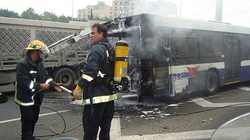
Buses crash for a number of reasons including driver fatigue, faulty equipment, passenger disruptions, and distracted driving. Whether it is a school bus or a city bus, the accident creates a situation where a large number of people can be seriously injured in a single incident.
Negligence is a Common Cause of Bus Accidents
Negligence on the part of the bus company is a leading cause of accidents. Negligent actions include failure to properly maintain brake and safety systems designed to prevent an accident, failure to properly train drivers, scheduling drivers to work beyond their hours of service limitations, and failure to properly screen drivers for drug/alcohol abuse.
Negligence on the part of the driver is also a common factor in mass transportation accidents. Negligent driving behaviors including working beyond hours of service limitations, failing to abide by posted speed limits, utilizing cell phones while driving, driving under the influence of drugs or alcohol, and driving while drowsy are frequently cited causes of bus accidents. Driver errors including failure to leave enough room between vehicles as well as failure to correctly follow and respond to road signs can also cause an accident.
Weather Related Causes
High winds, rain, snow, and ice negatively impact the handling characteristics of large vehicles including buses. When inclement weather is present, drivers are responsible for operating their vehicle in a manner that is safe for conditions, including the use of snow chains and deicing solutions when snow and ice are present. Driving for conditions also includes factoring in the size and weight of the bus and adjusting driving behaviors so that the driver can keep the vehicle under control throughout the duration of the route.
Mechanical Causes
Mechanical causes of bus accidents include improperly maintained brakes, improperly inflated tires, inadequately lubricated components, and excess loading that causes transmissions and engines to overheat and fail. When a mechanical failure occurs it can cause the bus to veer out of control. Further, when the mechanical components are not properly maintained, it can lead to the buildup of grease and other flammable materials within the engine compartment.
Up to 60% of all bus fires originate within the engine compartment and are caused by leaking hoses that allow flammable fluids to make contact with the hot surface of the engine causing it to ignite. Next to engine fires, the second most common cause of bus fires is tires that are underinflated or tires that are overinflated and “blow out.” This causes the rim of the tire to make contact with the road surface and the resulting heat and sparks that build up ignite the tire and insulation within the wheel well.
Children are at Considerable Risk of Injury
Unlike passenger vehicles, city buses and school buses are not required to provide seat belts to riders. Legislation is currently under consideration in Illinois that would require school districts to install these on public school buses. However, it has yet to become law even as the National Highway Transportation Safety Administration and National Traffic Safety Board urge adoption of such laws. Until seat belts are standard on school buses, it means that children will remain at considerable risk of serious personal injury or death when an accident occurs.
From 2006 to 2015, there were 1,172 fatal collisions involving school buses. In total, these killed 1,313 individuals which are an average of 131 per year. Occupants of school buses accounted for 9% of these fatalities. Pedestrians and bicyclists accounted for 20%. During the period from 2006 to 2015, 103 of those who died were under the age of 18.
Those at greatest risk of serious injury or death in accidents involving school buses are the drivers and occupants of passenger vehicles. They accounted for 72% of fatalities due in large part to the vast disparity in the size and design of the buses and passenger vehicles, light trucks, etc. School buses can weigh up to 42,000 pounds when fully loaded, while a typical passenger vehicle weighs just 3,000 pounds. Thus, even at low-speed a school bus can cause considerable damage to the smaller vehicle.
Accidents involving other vehicles and pedestrians often occur in the blind spots of the bus. These include the blind spots located within the few feet in front of the bus, along with both the sides of the bus, in particular, the side opposite the driver, and to the rear.
The most dangerous time for bus accidents is between 3pm and 4pm. This is followed by the period from 7am to 8am. It is during these times that most schools start and finish daily operations. Other significantly dangerous times include the period from 6am to 7am, and 4pm to 5pm when children are transported towards school and to and from extracurricular activities such as football games, band practice, etc.

